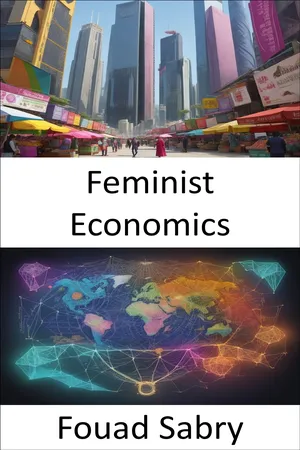
Feminist Economics
Transforming Economics, Unveiling the Power of Feminist Perspectives
- English
- ePUB (mobile friendly)
- Available on iOS & Android
About this book
What is Feminist Economics
The study of economics and economies from a critical perspective, with a particular emphasis on gender-aware and inclusive economic research and policy analysis, is referred to as feminist economics. Academics, activists, policy theorists, and practitioners are considered to be members of the feminist economic research community. There is a significant amount of research that is conducted by feminists in the field of economics that focuses on topics that have been neglected in the field, such as care work and intimate partner violence. Additionally, significant research is conducted on economic theories that could be improved by better incorporating gendered effects and interactions, such as between paid and unpaid sectors of economies. Additional feminist scholars have been involved in the development of novel approaches to data gathering and measurement, such as the Gender Empowerment Measure (GEM), as well as theories that are more gender-conscious, such as the capacities approach. The purpose of feminist economics is to "improve the well-being of children, women, and men in local, national, and transnational communities." This is something that feminist economics strives to do.
How you will benefit
(I) Insights, and validations about the following topics:
Chapter 1: Feminist economics
Chapter 2: Feminization of poverty
Chapter 3: Double burden
Chapter 4: Family economics
Chapter 5: Marianne Ferber
Chapter 6: Nancy Folbre
Chapter 7: Bina Agarwal
Chapter 8: Barbara Bergmann
Chapter 9: Julie A. Nelson
Chapter 10: Unpaid work
Chapter 11: Care work
Chapter 12: Lourdes Beneria
Chapter 13: Work intensity
Chapter 14: If Women Counted
Chapter 15: Gender and development
Chapter 16: Ailsa McKay
Chapter 17: Non-monetary economy
Chapter 18: Valuation of nonmarket housework
Chapter 19: Naila Kabeer
Chapter 20: Susan Himmelweit
Chapter 21: Shahra Razavi
(II) Answering the public top questions about feminist economics.
(III) Real world examples for the usage of feminist economics in many fields.
(IV) Rich glossary featuring over 1200 terms to unlock a comprehensive understanding of feminist economics. (eBook only).
Who will benefit
Professionals, undergraduate and graduate students, enthusiasts, hobbyists, and those who want to go beyond basic knowledge or information for any kind of feminist economics.
Frequently asked questions
- Essential is ideal for learners and professionals who enjoy exploring a wide range of subjects. Access the Essential Library with 800,000+ trusted titles and best-sellers across business, personal growth, and the humanities. Includes unlimited reading time and Standard Read Aloud voice.
- Complete: Perfect for advanced learners and researchers needing full, unrestricted access. Unlock 1.4M+ books across hundreds of subjects, including academic and specialized titles. The Complete Plan also includes advanced features like Premium Read Aloud and Research Assistant.
Please note we cannot support devices running on iOS 13 and Android 7 or earlier. Learn more about using the app.
Information
Table of contents
- Chapter 1: Feminist economics
- Chapter 2: Feminization of poverty
- Chapter 3: Double burden
- Chapter 4: Family economics
- Chapter 5: Marianne Ferber
- Chapter 6: Nancy Folbre
- Chapter 7: Bina Agarwal
- Chapter 8: Barbara Bergmann
- Chapter 9: Julie A. Nelson
- Chapter 10: Unpaid work
- Chapter 11: Care work
- Chapter 12: Lourdes Beneria
- Chapter 13: Work intensity
- Chapter 14: If Women Counted
- Chapter 15: Gender and development
- Chapter 16: Ailsa McKay
- Chapter 17: Non-monetary economy
- Chapter 18: Valuation of nonmarket housework
- Chapter 19: Naila Kabeer
- Chapter 20: Susan Himmelweit
- Chapter 21: Shahra Razavi
- Epilogue
- Appendix
- About the Author